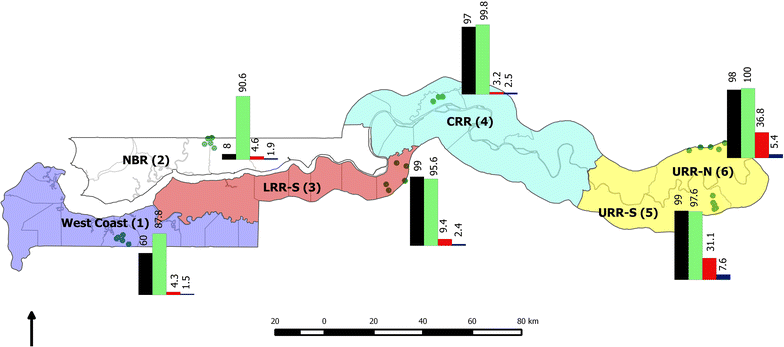On-going malaria transmission in The Gambia despite high coverage of control interventions: a nationwide cross-sectional survey
- PMID: 26268225
- PMCID: PMC4535679
- DOI: 10.1186/s12936-015-0829-6
On-going malaria transmission in The Gambia despite high coverage of control interventions: a nationwide cross-sectional survey
Abstract
Background: As indicators of burden of malaria have substantially decreased in The Gambia, reaching a pre-elimination status may be attainable. Achieving this goal requires in-depth understanding of the current burden of Plasmodium falciparum infection.
Methods: A nationwide cross-sectional survey was conducted in 2012 to determine the prevalence of P. falciparum infection, and to describe its heterogeneity and associated risk factors. Finger-prick blood samples were collected for microscopy, species-specific PCR and haemoglobin measurement.
Results: A total of 9,094 participants were included and median age was 11.9 years (IQR 5, 28). Overall prevalence of P. falciparum was 16.01 % with marked heterogeneity between sites (4.32-36.75 %) and within villages in each site (1.63-49.13 %). Across all sites, 51.17 % (745/1,456) of infections were asymptomatic and 35.61 % (448/1,258) were sub-microscopic. The odds of P. falciparum infection were higher in older children; 5-15 years (OR = 1.90; 95 % CI 1.60-2.26), adults (OR = 1.48; 95 % CI 1.24-1.78) and participants with moderate anaemia (OR = 1.62; 95 % CI 1.32-1.99).
Conclusions: The current malaria control interventions are not sufficient to interrupt transmission in The Gambia as malaria prevalence is still relatively high in the eastern part of the country. New interventions aiming at interrupting transmission are needed and should be urgently evaluated.
Figures


References
-
- WHO . World malaria report. Geneva: World Health Organization; 2011.
Publication types
MeSH terms
Grants and funding
LinkOut - more resources
Full Text Sources
Other Literature Sources
Research Materials

